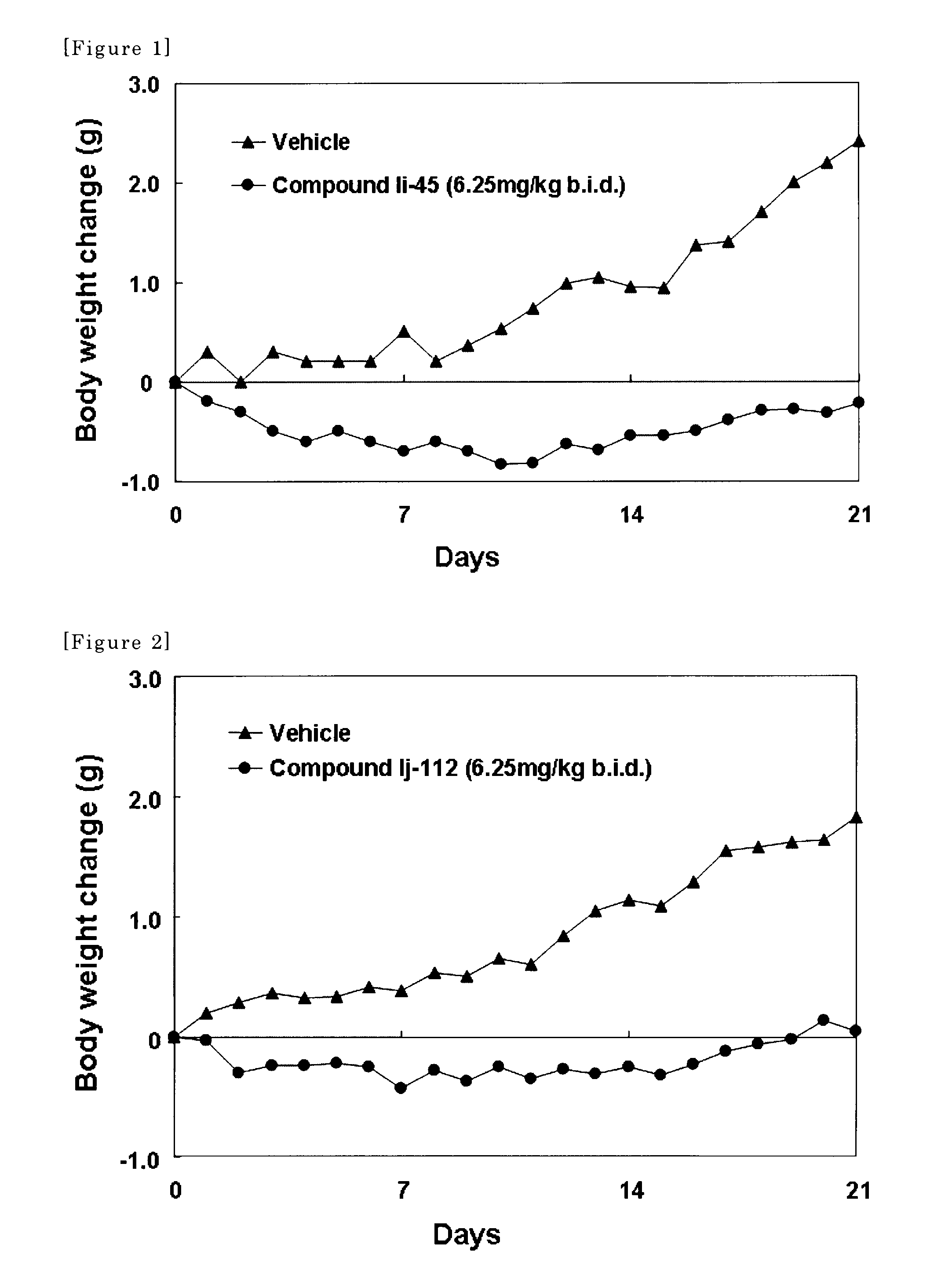Amine-derivatives having npy y5 receptor antagonistic activity and the uses thereof
- Summary
- Abstract
- Description
- Claims
- Application Information
AI Technical Summary
Benefits of technology
Problems solved by technology
Method used
Image
Examples
example
Example 1
Synthesis of Compound (Ii-1)
Step 1
[0157]
[0158]3-Fluoronitrobenzene (2.00 g, 14.2 mmol) was dissolved in dimethylsulfoxide (15 ml). 3,5-Dimethylpiperidine (3.21 g, 28.4 mmol) and potassium carbonate (3.92 g, 28.4 mmol) were added thereto and the mixture was stirred for 3 hours at 150° C. The reactant was poured into water and extracted with ethyl acetate. The organic layer was washed with water and dried over sodium sulphate anhydrous. The solvent was removed under reduced pressure. Ethyl acetate and hexane were added to the residue. The precipitated crystals were collected with filtration to give the desired substituted nitrobenzene (2.05 g, 62% yield).
[0159]1H-NMR (CDCl3) δ ppm: 0.76 (q, 1H, J=12.0 Hz), 0.96 (d, 6H, J=6.3 Hz), 1.70-1.91 (m, 3H), 2.32 (t, 2H, J=12.0 Hz), 3.62-3.72 (m, 2H), 7.17-7.25 (m, 1H), 7.34 (t, 1H, J=8.1 Hz), 7.59 (d, 1H, J=8.1 Hz), 7.71 (s, 1H).
Step 2
[0160]
[0161]The compound obtained in Step 1 (2.05 g, 8.75 mmol) was dissolved in ethanol (25 ml) and ...
example 2
Synthesis of Compound (Ij-1)
Step 1
[0173]
[0174]Amine (1.20 g, 3.64 mmol) and 2-chloro-5-trifluoromethylpyridine (727 mg, 4.01 mmol) was suspended in isopropanol (4 ml) and N,N-diisopropyl ethyl amine (1.87 ml, 10.9 mmol) was added thereto. After the mixture was in sealed tubes, the reaction was carried out by a microwave reactor for 1 hour at 160° C. The reactant was poured into water and extracted with ethyl acetate. The organic layer was washed with water and dried over sodium sulphate anhydrous. The solvent was removed under reduced pressure and the residue was purified by silica gel chromatography to give the desired Ester (222 mg, 20% yield).
Step 2
[0175]
[0176]Ester obtained in Step 1 (207 mg, 0.685 mmol) was dissolved in tetrahydrofuran (3 ml). Lithium aluminum hydride (31.1 mg, 0.822 mmol) was added thereto under ice-cooling and the mixture was stirred at room temperature for 0.5 hour. The reactant was poured into iced water and extracted with ethyl acetate. The organic layer w...
example 3
Synthesis of Compound (Ij-62)
Step 1
[0181]
[0182]Amine (132 g, 401 mmol) was suspended in dichloromethane (1000 ml) under ice-cooling. Triethylamine (123 ml, 882 mmol) and (Boc)2O (101 ml, 440 mmol) were sequentially added thereto and stirred for 10 minutes. After that, the mixture was stirred at room temperature for 2 hours and the solvent was removed. The residue was poured into aqueous citric acid (citric acid monohydrate 50 g in water 400 ml) to become pH4 and extracted with ethyl acetate. The organic layer was washed with water and dried over magnesium sulfate anhydrous. The solvent was removed under reduced pressure to quantitatively give the target compound.
[0183]1H-NMR (DMSO-d6) δ ppm: 1.06-1.25 (m, 2H), 1.25-1.43 (m, 2H), 1.37 (s, 9H), 1.75-1.94 (m, 4H), 2.19 (tt, 1H, J=11.7, 3.9 Hz), 3.07-3.24 (m, 1H), 3.58 (s, 3H), 6.74 (d, 1H, J=6.6 Hz).
Step 2
[0184]
[0185]Lithium aluminum hydride (18.3 g, 483 mmol) was suspended in tetrahydrofuran (800 ml) and ester in tetrahydrofuran (300 ...
PUM
| Property | Measurement | Unit |
|---|---|---|
| pH | aaaaa | aaaaa |
| weight | aaaaa | aaaaa |
| pH | aaaaa | aaaaa |
Abstract
Description
Claims
Application Information
 Login to View More
Login to View More - R&D
- Intellectual Property
- Life Sciences
- Materials
- Tech Scout
- Unparalleled Data Quality
- Higher Quality Content
- 60% Fewer Hallucinations
Browse by: Latest US Patents, China's latest patents, Technical Efficacy Thesaurus, Application Domain, Technology Topic, Popular Technical Reports.
© 2025 PatSnap. All rights reserved.Legal|Privacy policy|Modern Slavery Act Transparency Statement|Sitemap|About US| Contact US: help@patsnap.com



